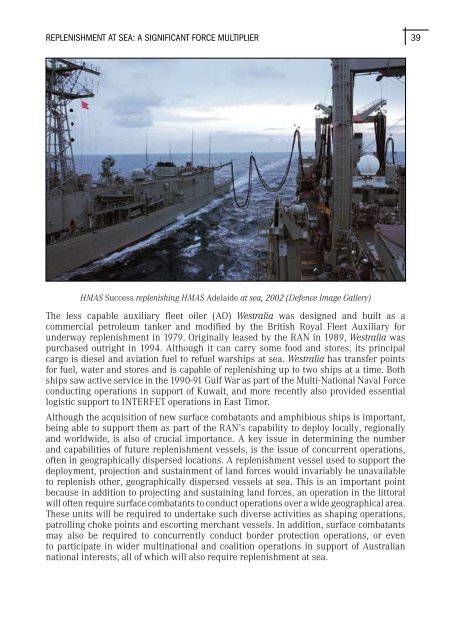Australian Maritime Issues 2005 - Royal Australian Navy
Australian Maritime Issues 2005 - Royal Australian Navy
Australian Maritime Issues 2005 - Royal Australian Navy
Create successful ePaper yourself
Turn your PDF publications into a flip-book with our unique Google optimized e-Paper software.
REPLENISHMENT AT SEA: A SIGNIFICANT FORCE MULTIPLIER<br />
39<br />
HMAS Success replenishing HMAS Adelaide at sea, 2002 (Defence Image Gallery)<br />
The less capable auxiliary fleet oiler (AO) Westralia was designed and built as a<br />
commercial petroleum tanker and modified by the British <strong>Royal</strong> Fleet Auxiliary for<br />
underway replenishment in 1979. Originally leased by the RAN in 1989, Westralia was<br />
purchased outright in 1994. Although it can carry some food and stores, its principal<br />
cargo is diesel and aviation fuel to refuel warships at sea. Westralia has transfer points<br />
for fuel, water and stores and is capable of replenishing up to two ships at a time. Both<br />
ships saw active service in the 1990-91 Gulf War as part of the Multi-National Naval Force<br />
conducting operations in support of Kuwait, and more recently also provided essential<br />
logistic support to INTERFET operations in East Timor.<br />
Although the acquisition of new surface combatants and amphibious ships is important,<br />
being able to support them as part of the RAN’s capability to deploy locally, regionally<br />
and worldwide, is also of crucial importance. A key issue in determining the number<br />
and capabilities of future replenishment vessels, is the issue of concurrent operations,<br />
often in geographically dispersed locations. A replenishment vessel used to support the<br />
deployment, projection and sustainment of land forces would invariably be unavailable<br />
to replenish other, geographically dispersed vessels at sea. This is an important point<br />
because in addition to projecting and sustaining land forces, an operation in the littoral<br />
will often require surface combatants to conduct operations over a wide geographical area.<br />
These units will be required to undertake such diverse activities as shaping operations,<br />
patrolling choke points and escorting merchant vessels. In addition, surface combatants<br />
may also be required to concurrently conduct border protection operations, or even<br />
to participate in wider multinational and coalition operations in support of <strong>Australian</strong><br />
national interests, all of which will also require replenishment at sea.

















